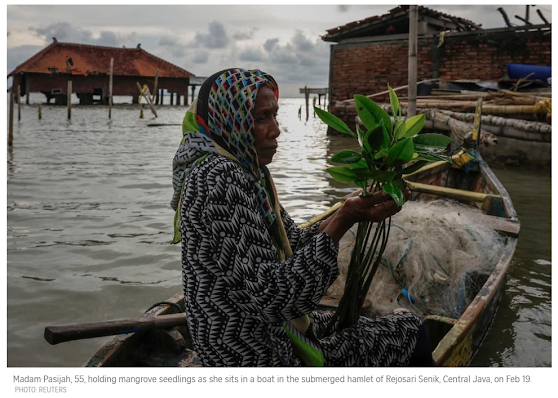‘The flood waters come in waves’: Indonesian woman plants mangroves to fend off rising tides
DEMAK, Indonesia - Madam Pasijah, a 55-year-old housewife in Indonesia’s Central Java province, wakes up every morning to the sound of the sea. If that sounds idyllic, it is anything but.
Her home is the only one remaining in this part of Rejosari Senik, a small village on Java’s northern coast that was once on dry land but is now submerged by water.
Over the past few years, her neighbours have abandoned their homes, vegetable plots and rice fields to the advancing sea, but she and her family have no plans to leave.
“I do have every intention to stay here, and my feelings for this house remain,” she told Reuters in February.
Water laps around the walls of her house, where she has lived for 35 years, soaking her feet when she steps outside.
Fenced by haphazard rows of bamboo and a broken power pole, the floor inside has been raised to keep it above sea level.
The nearest land is 2km away and the closest city, Demak, farther still at 19km. The only way to get there is by boat.
Indonesia, an archipelago of thousands of islands, has about 81,000km of coastline, making it particularly vulnerable to rising seas and erosion.
Sea levels on the country’s coasts rose an average of 4.25mm annually from 1992 to 2024, but the rate has accelerated in recent years, Mr Kadarsah, a climate change official at Indonesia’s Meteorology, Climatology and Geophysical Agency, told Reuters.
“One of the signs of climate change is the rising sea levels,” he said, adding that some small islands have disappeared.
He also pointed to increased pumping of groundwater that has exacerbated land subsidence along Java’s northern coast. The problem is particularly bad in the capital Jakarta, which is home to some 10 million people.
Indonesian authorities have turned to mega projects for a solution, including a 700km sea wall that would run along the northern coast between Banten and East Java provinces.
Madam Pasijah and her family, meanwhile, have turned to nature.
She has planted some 15,000 mangrove trees a year over the past two decades. Every day, she paddles out in a boat made from a blue plastic barrel to tend to the bushes and plant new saplings, lowering herself into the blue-grey water, which can come up to as high as her chest.
“The flood waters come in waves, gradually, not all at once,” she said. “I realised that after the waters began rising, I needed to plant mangrove trees so that they could spread and protect the house, from the wind and the waves.”
She and her family survive by selling fish caught by her sons in the nearest market. They say they will stay as long as they can hold back the tides.
“I’m no longer concerned about how I feel about the isolation here since I decided to stay, so we’ll take it one hurdle at a time,” she said. REUTERS
This article was originally published on The Straits Times. Its inclusion on this website is solely for education purposes.



No comments
Share your thoughts! Tell us your name and class for a gift (: